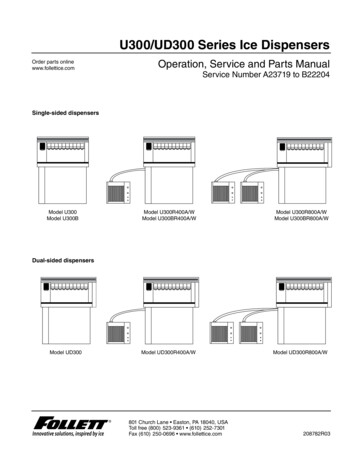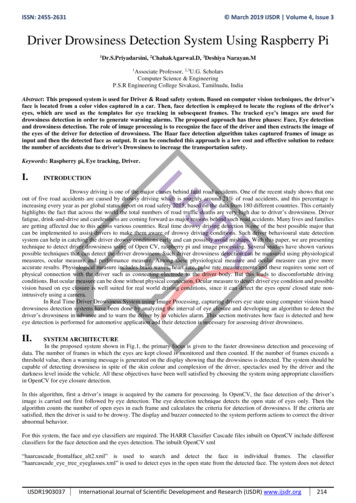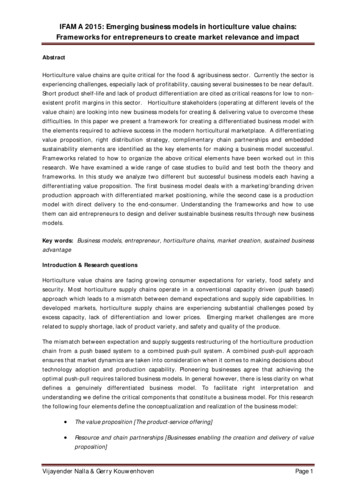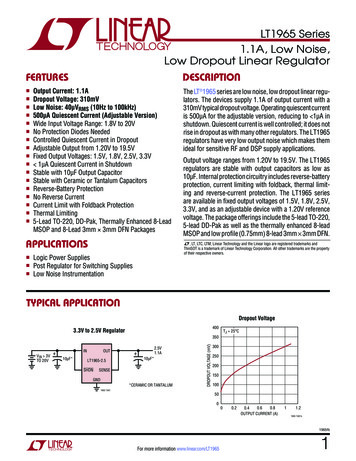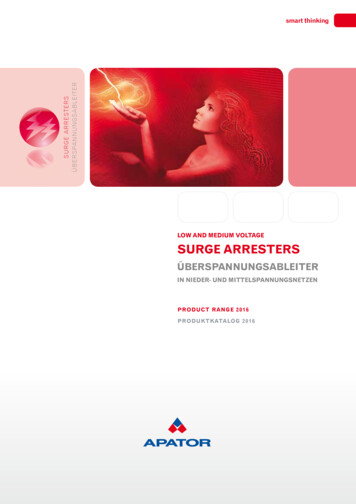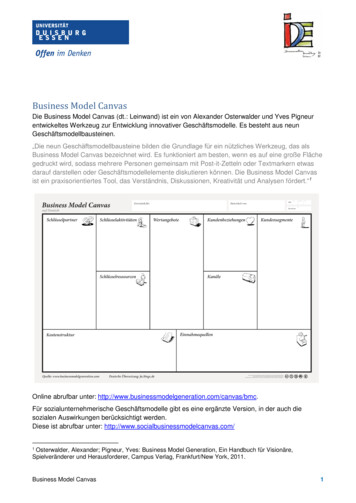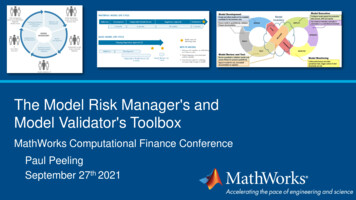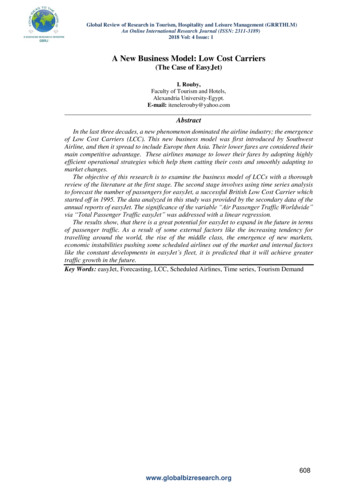
Transcription
Global Review of Research in Tourism, Hospitality and Leisure Management (GRRTHLM)An Online International Research Journal (ISSN: 2311-3189)2018 Vol: 4 Issue: 1A New Business Model: Low Cost Carriers(The Case of EasyJet)I. Rouby,Faculty of Tourism and Hotels,Alexandria University-Egypt.E-mail: itenelerouby@yahoo.comAbstractIn the last three decades, a new phenomenon dominated the airline industry; the emergenceof Low Cost Carriers (LCC). This new business model was first introduced by SouthwestAirline, and then it spread to include Europe then Asia. Their lower fares are considered theirmain competitive advantage. These airlines manage to lower their fares by adopting highlyefficient operational strategies which help them cutting their costs and smoothly adapting tomarket changes.The objective of this research is to examine the business model of LCCs with a thoroughreview of the literature at the first stage. The second stage involves using time series analysisto forecast the number of passengers for easyJet, a successful British Low Cost Carrier whichstarted off in 1995. The data analyzed in this study was provided by the secondary data of theannual reports of easyJet. The significance of the variable “Air Passenger Traffic Worldwide”via “Total Passenger Traffic easyJet” was addressed with a linear regression.The results show, that there is a great potential for easyJet to expand in the future in termsof passenger traffic. As a result of some external factors like the increasing tendency fortravelling around the world, the rise of the middle class, the emergence of new markets,economic instabilities pushing some scheduled airlines out of the market and internal factorslike the constant developments in easyJet’s fleet, it is predicted that it will achieve greatertraffic growth in the future.Key Words: easyJet, Forecasting, LCC, Scheduled Airlines, Time series, Tourism Demand608www.globalbizresearch.org
Global Review of Research in Tourism, Hospitality and Leisure Management (GRRTHLM)An Online International Research Journal (ISSN: 2311-3189)2018 Vol: 4 Issue: 11. IntroductionThe term Low Cost Carriers (LCCs) or Low Cost Airlines (LCA) can be referred to as “anycarrier with low ticket prices and limited services regardless of their operating costs” (Macarioet.al, 2008)Low cost carriers (LCC) have grown in the last three decades and have become a temptingalternative to Full Service Airlines (FSA). Low Cost Carriers utilize a business model thatreduces operational costs. In order to compensate revenue loss in tickets, they may chargecustomers for auxiliary services like meals, priority boarding and baggage. This new type ofservice airlines is one of the fastest growing economic segments and at times, LCCs were theonly sector growing in periods of economic and political uncertainty (Eurocontrol, 2017).According to (InterVISTAS, 2013), these carriers have been demonstrating sustainedgrowth, with gradually increasing fleet sizes, number of passengers served, revenues, and inmany cases profits. It is typical to start operating with three or so aircraft, and then steadily addcapacity. Their growth rates in their first years may reach 100% which then soothes to 30-60%at the two to eight year point.LCCs have played a fundamental role in the expansion of the aviation industry in the lastdecades and it is expected that their growth will continue. Since the emergence of SouthwestAirlines in the U.S., there have been several attempts to implement LCCs business models butwith no success. That was due to government barriers, airport and other infrastructureconstraints and lack of knowledge of how to successfully implement the new business model.Nowadays, LCCs are one of the major components of the aviation market. Their rise can bereferred to several reasons. Firstly, due to market liberalization in many countries in additionto air service agreements, LCCs seized the opportunity to offer innovative services and lurenew customers looking for air services with low prices. In 2015, the European LCCs captured41% of the seat capacity in Europe. In Africa, although market access barriers are high, theshare of LCCs within the region is at 9% while in Asia, the LCCs share accounted for 23%.Secondly, LCCs managed to offer what potential air service customers value and respondedto customer needs, namely good quality for lower prices. Thirdly, LCCs have respondedquickly to market conditions and understood that keeping a competitive advantage requires aruthless force to cut costs, increase revenues, and maximize efficiency.LCCs were able to compete with FSAs, because they were able to lower their costs as theydon’t offer the same level of amenities, they don t manage the same degree of connectivity ofFSAs and they don’t have to bear legacy costs. As passengers nowadays don’t need networkconnectivity for all their journeys or don’t need service amenities, these travelers are willing tosubstitute the FSAs product for LCC trips. If FSAs were to lower their costs in response to LCCstrategies, they would decrease their revenues.609www.globalbizresearch.org
Global Review of Research in Tourism, Hospitality and Leisure Management (GRRTHLM)An Online International Research Journal (ISSN: 2311-3189)2018 Vol: 4 Issue: 1The objective of this research is to examine the business model of LCCs, which is consideredthe key driver to cost reductions giving them the opportunity for lower-priced offerings. Theresearch also highlights the reaction of FSAs towards the fierce invasion of LCCs of the airservice market. In addition, the potential for future growth of traffic for easyJet was tested usingtime series forecasting.This research is divided into two parts. The first part consists of a thorough review of theliterature to examine the new business model of LCCs versus FSA (Full Service Airlines). Thesecond part, covering the methodology of research, was dedicated to hypotheses testing. Itcomprised of applying times series forecasting on the secondary data of monthly passengertraffic of easyJet covering the period from January 2004 till February 2018. A linear regressionanalysis was conducted to simulate cause and affect relationship between variables “AirPassenger Traffic Worldwide” and “Total Passenger Traffic easyJet”. Also Pearson’scorrelation coefficient was calculated to examine direction and magnitude of associationbetween variables “crude oil prices” and “total air passengers worldwide” and “total passengertraffic easyJet”. The research hypothesized the following:H1: There is a significant relationship between easyJet air passenger traffic and number of airpassenger traffic worldwide.H2: There is a potential for growth in the future for easyJet in terms of passenger traffic.H3: There is a significant relationship between average crude oil prices and total airpassengers worldwide and total passengers of easyJet.2. Literature Review2.1 Changing Business EnvironmentIt is crucial to examine the changing market environment within which the aviation industryhas been operating and which has affected its development in recent years.Liberalization of the economy means “to free it from direct or physical controls imposed bythe government”. The most affecting trend which revolutionized the structure and operatingmodels of the aviation industry was the liberalization of international air transport.Consequently, many governments allowed the emergence of new domestic and/or internationalairlines able to compete directly with their established national carriers. For example, state ofthe European Union (EU) can benefit from open skies with unconstrained market access to anyroutes for airlines and the elimination of all capacity, price controls and ownership limitations(Cento, 2009).The decline in traffic growth rates had also affected the development of air transport. Inabsolute traffic terms a 2.0 % growth in 2004 compared to a 12 per cent rise in the late 1960simplies a noteworthy slow-down in the traffic growth rate.610www.globalbizresearch.org
Global Review of Research in Tourism, Hospitality and Leisure Management (GRRTHLM)An Online International Research Journal (ISSN: 2311-3189)2018 Vol: 4 Issue: 1Also the decline in yield – that is the average revenue produced per passenger-kms or tonnekms carried was one of the factors significantly affecting aviation industry.Air transport is considered a capital intensive industry with small marginal profits.Therefore, airlines always try to keep their operational cost as low as possible as there are somecosts that cannot be controlled by management like fuel costs (The World Bank, 2014). Porter(2008) explained that the airline industry has the lowest average return on invested capital(ROIC) if compared to a list of selected industries. The average ROIC for airlines was a mere6.9% between 1992 and 2006, where top performing sectors, had an average ROIC above 40%.Therefore, the LCCs business strategies focused primarily on reducing operating costs whichconsequently intensified the competition with FSAs which are burdened by high legacy andoperational costs.2.2 Key Elements of the New Business ModelIn their study Francis et al. (2006) developed a typology, distinguishing among five broadtypes of low cost carriers:a. The Southwest copy-cats – Airlines that started from scratch as LCCs.b. Subsidiaries – Airlines that have been set up as subsidiaries of “legacy” airlines and emergedto get back a part of the market of legacy airlines that was taken away by LCCs.c. Cost cutters – Are long established “legacy” airlines which are trying to adopt cost cuttingstrategies like charging passengers for meals or offering low cost one way tickets.d. Diversified charter carriers – Low-cost subsidiaries developed by charter airlines.e. State-subsidized companies – These are not true low cost carriers but they act in the marketas if they were. They are financially supported by government ownership or subsidies allowingthem to offer low fares without the need to cover their long run average costs.LCCs are characterized by a business model that relies primarily on some key elements.These include:Service Offering: The unbundling of fares is one of the characteristics of the low-cost airlinebusiness model, which concentrates on separating the product into distinct elements (Fageda etal., 2015). These elements are sold separately. This results in cost reductions and offersopportunities for revenues. Food and beverage for instance are offered for an extra charge. MostLCCs have no pre-assigned seating arrangements and operate on a first-come, first-served basis.However, some LCCs such as easyJet have started issuing “speedy boarding” tickets that canbe purchased in advance. Also LCCs have firm rules concerning luggage weights perpassengers. Some tickets don’t include any checked-in luggage and have to be purchasedseparately (Vidiovic et al., 2006.)Point-To-Point versus Hub-and-Spoke Structures: The majority of LCCs focus on point topoint routes in contrast to “hub-and spoke” system adopted by FSAs. The “Spoke” flights611www.globalbizresearch.org
Global Review of Research in Tourism, Hospitality and Leisure Management (GRRTHLM)An Online International Research Journal (ISSN: 2311-3189)2018 Vol: 4 Issue: 1assemble the passengers in one or more “hub” airports where passengers continue their flightsonward from these hubs. This operation is very expensive because of the excessive use ofinfrastructure such as ground equipment and runways. Furthermore, in times of congestion,diseconomies of scale may arise because hubs have to deal with these congestions leading tohigher fuel consumption and labor costs (Vidiovic et al., 2013).LCCs in contrast are able to reduce costs by offering point-to-point routes, benefiting fromeconomies of scale and enhanced utilization of facilities and employees.Usage of Secondary Airports: LCCs usually use secondary airports for the followingreasons: lower airport charges, the availability of slots, and reduced congestion. In addition tothat, LCCs manage to get incentives from remote airports. Local authorities recognize thatLCCs are considered a potential driver for social and economic developments, and are willingto provide financial help such as tax exemption and marketing support (Soyk et al., 2017).Additional cost reduction factors include the use of a standardized fleet of cost-efficient andfuel-saving aircrafts, allowing a better flexibility of crew assignment and savings in training,qualification and stock of spare parts (Franke, 2004). In addition to standardized service, freeservices on board are omitted and intermediaries are bypassed. Reservations are made online(easy-Jet sells 95% of its seats in this way) or by telephone. Offering point-to-point tickets withno connections simplifies luggage handling and increases planes turnaround. No pre-assignedseating, no frequent flyer programs and non-integration into alliances is the rule. In addition,no compensation to passengers is offered in the form of a hotel reservation or transfer to anotherairline if a flight is cancelled or delayed. They get additional revenues by offering direct orindirect services such as car rentals or hotel reservations. They rent advertising possibilities onboard or on the Internet. Some figures show that the LCCs workers are paid less than theirfellow workers in the FSAs although having a heavier workload (Gillen et al., 2004).The following table (1) summarizes key elements of the business models adopted by LCCsand FSAs.Table 1: Key Elements of Business Models of LCCs and FSAsFeatureLLC StrategyFSA StrategyCostsSimple processes to reduce costs.Reduced training, servicing as wellas crew and maintenance costs.Collective agreements and network serviceresult in complex processes. Thus, theadoption of continuous reforms andimprovement management strategies areonly initiatives with no strategic alterations.HubsHubs are largely results of marketsizes.Hubs are strategic mes offered but aren’t aprimary product dimension.Hubs are built to maximize the number ofpossible connections with shortest possibleconnection times. This results in the need for612www.globalbizresearch.org
Global Review of Research in Tourism, Hospitality and Leisure Management (GRRTHLM)An Online International Research Journal (ISSN: 2311-3189)2018 Vol: 4 Issue: 1extra resources (e.g., more gates, moreaircrafts) to accommodate large demands.Interline principles are a core concept forFSAs. Considerable investments are made tohandle interline connectivity.InterlineconnectivityInterlining is rare. It requiressignificant additional costs andsystems investments.Code shareSome cases exist, but are relativelyrare and not a major focus of thecarrier.A key strategic practice which allows theFSA to sell a network of services.SecondaryairportsSome LCCs have used this as animportant business strategy forcheaper airport fees while othershave combined the use of secondarywith primary airports.Outsourcing of most non-flying jobs(ground handling, call centers,aircraft maintenance).FSAs often serve secondary markets inregions from their hubs.AlliancesNot observed.Class of serviceGenerally one class, but in somecases business class seating andamenities are provided. No seatallocation for faster boarding.LCCs typically operate a singleaircraft type to maximize aircraftutilization. Some indication thatLCCs may adopt large regional jets.LCCs mainly focus on bare bonesservices. Increasingly LCCs areadding some service enhancements,such as lounges, frequent flyerprograms, however, these areprovided on a fee for use.A key strategic development to meetconsumer demand for service from largenetwork carriers.Largely based on two classes, business andeconomy and sometimes first class oninternational and oceanic flights.Singleaircraft type.ServicestrategiesIn order to serve as many markets as possibleand connect them, the adoption of multipleaircraft types, with each suited to differentroute lengths and traffic densities is needed.FSAs typically offer a range of value addedservices.CustomerServiceorientationMost LCCs have successfullydeveloped a strong customer serviceculture.Adequate customer service culture amongemployees.ProductbundlingThe LCC offers a core product at alow price.Additional services, such as loungeaccess, meals and beverages aretypically sold. Frequent flyerrewards are offered when a higherfare is booked.FSAs offer bundled air services as a matter ofstrategic choice and legacy. This will includefeatures such as lounge access at no chargefor frequent travelers, on board meals onmedium and long haul flights, and frequentflyer rewards.Seating featuresOften very dense some do not havepre-assigned seatingDistributionchannelsPreference is online and direct salesto save the commissions ofintermediariesLCCs use a minimum number ofcabin crew usually performingmultiple tasks. Lower wage scales ifcompared to FSAs and wages areusually performance- based.Varies by route, international routes offer alarger seating area, pre-assigned seatingdominates.Increasing movement towards online anddirect sales to reduce commissions to thirdparties.Adequate number of cabin crew and highaverage wages with unionization.Personnel613www.globalbizresearch.org
Global Review of Research in Tourism, Hospitality and Leisure Management (GRRTHLM)An Online International Research Journal (ISSN: 2311-3189)2018 Vol: 4 Issue: 1No rebooking and no refundTicket policiesFlexibility for rebooking or refund andsometimes for some fees.Source: InterVISTAS (2013) and Macário et al. (2008)A prerequisite for a sustainable success of LCCs are low cost operations. As explained inMagill (2014), a low cost pattern can save up 35% to 50 % costs through operational andmanagerial features (Figure1). The traditional airlines are also trying to reduce costs as well butthey lag far behind the LCCs. The philosophy of FSAs is to focus on passengers with awillingness to pay.Figure 1: Unit Cost Advantage is Derived from Many FactorsSource: Magill (2014)Some trends worldwide acted as catalysts to intensify the Low Cost Carrier phenomenon.These include regulatory framework; degree of entrepreneurship; density of population andrelative wealth; travelling culture; airport availability; adherence to internet facilities. There isa direct relation between these factors and the development of societies and development lifecycle of Low Cost Airlines.The strategy of price discriminations is used by many industries especially in transportindustries to reduce costs. This is favorable to use, when separating markets can yield moreprofits than keeping markets combined. This strategy depends on the elasticities of demand ofclustered markets. Customers in rather inelastic sub-market are charged a higher price, whileconsumers in the relatively elastic sub-market are charged a lower price (Investopedia, 2018).According to Dhingra et al. (2018) both FSAs and LCCs engage in price discriminationschemes, in the sense that travelers purchasing tickets at different points in time before a flight,or with different restrictions on the use of the ticket, pay different pricesLCCs have removed the barriers of the need to purchase a return ticket in order to get lowerprices. They also removed the minimum and maximum stay requirements which were inaddition to low priced one way tickets considered a huge leap in the air pricing methodologies.614www.globalbizresearch.org
Global Review of Research in Tourism, Hospitality and Leisure Management (GRRTHLM)An Online International Research Journal (ISSN: 2311-3189)2018 Vol: 4 Issue: 1According to Macario et al., 2008, so far most LCCs have tried to avoid mutual competition.For instance, Ryanair, focused on smaller markets and regional airports, while easyJet isfocusing on bigger markets and primary airports. Three scenarios may arise. LCCs willcontinue to avoid competition or a price war will be set off or else consolidation and theemergence of alliances will take place. Historical experience in the Air Transport businesspoints to consolidation and the possible emergence of alliances.Evidence of competition between air transport services and other modes of transport exist.Chen et al. (2015) found a substantial increase in competition between air transport servicesand rail services. The two main United States’ road companies were forced to cut prices in orderto reduce the shift of passenger to the LCCs. The rail company - Amtrak - for instance had tocut prices and introduced special deals for passengers.The high speed train (HST) in Europe intensified the competition because it is the only landtransport resolution than can directly compete in term of travel times for routes up to 500km.There has also been evidence of cooperation between airlines and HST. For example, Charlesde Gaulle airport in Paris is directly served by the TGV network enabling Air France tocompete, for passengers living in the Brussels region.Two main operating approaches for LCCs in the market are either to open new markets orto enter old established markets competing with other airlines. Ryanair, follows primarily thefirst strategy. They first identify untapped markets, and then they search for secondary airportsto serve these routes. In addition, they look for the support of authorities looking for fiscalincentives. Governments usually support such initiatives to induce social and economicdevelopment. The other strategy is being followed by easyJet. This airline prefers to penetratelarge markets competing with other airlines by offering high frequencies and lower fares.LCCs have a high load factor up to 80%, accommodation of a larger numbers of passengers,paying cheaper taxes since they use secondary airports, short haul flights without connections,reducing the negative effect of air transport on the environment by consuming less fuel thusdecreasing emissions of harmful substances into the environment. Some 25% of Asian interregion seats are flown by these airlines, in Europe it is over 40%. Today, LCCs representapproximately 40% of the “Available Seat Kilometers” flown between European countries ordomestically (Eurocontrol, 2017).The following table (2) demonstrates the application of Porters five forces model on LCCsand the justification for the level of strength that was associated to each factor.615www.globalbizresearch.org
Global Review of Research in Tourism, Hospitality and Leisure Management (GRRTHLM)An Online International Research Journal (ISSN: 2311-3189)2018 Vol: 4 Issue: 1Table 2: The Effect of Porters’ Five Forces on LCCs Market PenetrationPorters five forcesStrengthJustificationThreat of new entrantsMediumDeregulations and demand growth can be thedrivers for more potential players although somemarkets like the European market are alreadysaturated. Some other markets like the MiddleEast with a limited number of LCCs show morepotential for new entrants.Threats of SubstitutesMedium toLowThere is a threat for substitution in markets wheretrain network is developed and has a highnetwork of connectivity. But again in thesemarkets long haul routes are to be accomplishedby air services.Nevertheless, in markets such as the Middle East,where train network is in its infancy state, railnetwork is in no direct competition with LCC’s.Bargaining Power ofCustomersHighThe reason that a customer will opt for an LCC isits cheap price. They can shift from one airline toanother due to lower price offerings.Bargaining Power ofSuppliersMediumThe aircraft supply side is monopolized by twomajor manufacturers, namely Airbus and Boeing.However the competition between the twocompetitors is severe. This allows airlines to getcompetitive pricing and good servicing whenpurchasing an aircraft.Also fuel companies pose some pressure onLCCs. Air service labor has also a bargainingpower as it comes from the fact that there are nosubstitutes for several classes of employees suchas pilots and mechanicsRivalry among CompetitorsHighThe major selling advantage of LCCs is their lowprices, which has resulted in a high competitionin the airline industry, where legacy airlines arefighting to protect themselves from losing theirmarket share. Also competition among LCCsdoes exist.The business model of FSAs differs from that of LCCs. FSAs focus on offering theircustomers high level of connectivity, therefore they were engaged in alliances to allow this kindof connectivity, to coordinate schedules, reduce connection times and maximize the number ofcities that can be linked together. Furthermore, FSAs have relatively high costs of labor andother service inputs. These legacy costs include labor compensation programs, productivityagreements, supplier relationships, and consumer expectations (InterVISTAS, 2013).The biggest disadvantages of hub-and-spoke model adopted by FSAs are the complexity ofconnecting flights in the given time frame and high utilization during peak periods (Vidovic etal.; 2013).616www.globalbizresearch.org
Global Review of Research in Tourism, Hospitality and Leisure Management (GRRTHLM)An Online International Research Journal (ISSN: 2311-3189)2018 Vol: 4 Issue: 1To counter the threat of LCC’s, Full Service Carriers designed sophisticated revenuemanagement softwares to separate leisure passengers from business travelers which enabledthem to optimize revenue from every passenger. FSAs also tried to defend their market shareby offering similar low prices of a new entrant, who was trying to operate from their hubs.Another strategy adopted by FSAs to keep their market share against aggressive competitionfrom LCCs was adding supplementary flights or using larger aircraft on routes entered by LCCsto keep the load factor of the new entrant at an unachievable level. FSAs lower the fares untilnew entrants depart from these hubs, then FSAs start raising their prices again and reducingtheir capacity. This procedure has made it difficult for LCCs to compete with FSAs in theirhubs (Barbot, 2004).However, some authors explained, that many FSAs aim to provide a high level of servicequality to improve customer satisfaction to replace the generic reputation of LCCs as low fares’providers. Balcombe et al. (2009) show that not only price but also service quality triggers thepassengers’ behaviors as well. This has led to the emergence of a hybrid model combiningtogether features of FSAs and LCCs business models in an attempt to sustain their business andmarket share.2.3 The Emergence of a Hybrid ModelDue to major changes in the global economy and consumer trends affecting directly theairline industry, FSAs and LCCs went through many changes.On the one hand, FSAs are trying to reduce their costs in order to compete with LCCs. Onthe other hand, LCCs are trying to tackle new markets once dominated by legacy airlines. Thus,a new operating model, the hybrid model emerged which combines elements from both legacyairlines and Low Cost Carriers. Some LCCs are adopting business models that include shiftingto primary airports, start hub and spoke activities, offering meals and other in-flight services aswell as entering alliances. As a result, FSAs are also trying to change and adapt their focus. Ahybrid model is a current business model that comprises the best features of both the legacyand low-cost business models in one, balancing costs which is the focus of LCCs and valuewhich is the focal point of FSAs (Avram, 2017).This model uses a mix of narrow- and wide-body aircraft models, utilizes third-partyaggregators, uses intermediaries, practices limited code sharing, facilitates interlining and fliesshort- and long-haul and Inter-regional flights (Sabre Holdings, 2010).The saturation of some LCCs markets and the slowdown in its growth forced them to shiftto business strategies traditionally used by full-service airlines; i.e. fare bundling, connectingflights and code sharing (de Wit et al.; 2012). Other studies (Henrickson et al., 2016;Dobruszkes et al., 2017) explained that LCCs are increasing their operations in main airportsalongside regional airports. However, other studies highlighted redirections in some other617www.globalbizresearch.org
Global Review of Research in Tourism, Hospitality and Leisure Management (GRRTHLM)An Online International Research Journal (ISSN: 2311-3189)2018 Vol: 4 Issue: 1respects such as employee productivity, homogeneous fleets, non-stop service and brandingstrategies (Daraban, 2012; Taylor et al., 2013).A large number of FSAs have implemented features from the LCC business model. Theystarted eliminating hot meals for flights. They have also simplified their fare structure andimplemented profit sharing plan for employees (e.g. Delta). Some of the FSAs have introducedtheir own Low Cost Airlines (Gillen et al., 2004).Low Cost Carriers have also adopted features from the Full Service Carriers in order todifferentiate their products including: Frequent flyer programs (Southwest); hub and spokenetwork systems (AirTran); in-flight entertainment (Frontier); and multiple aircraft type(JetBlue). As a result the line between Low Cost Carriers and Full Service Carriers hasdiminished substantially in terms of product offerings. However, LCCs still have a costadvantage over FSA although offering almost same products (Barbot 2004).A study by Bland (2014) showed that the price is the major advantage for LCCs. Some otherstudies examined other factors besides price such as booking convenience, in-flight services,schedule, safety consideration, and airline image (Chang et al., 2013; Diggines, 2010; Davisonet al., 2010). The consumer decision theory suggests that the price isn’t the single factor uponwhich consumers base their decisions (Blythe, 2013). There are other attitude and behavioralfactors which play a major role in the decision making process of LCC passengers.There aren’t any more a clear cut business strate
LCCs are characterized by a business model that relies primarily on some key elements. These include: Service Offering: The unbundling of fares is one of the characteristics of the low-cost airline business model, which concentrates on separating the product into distinct elements (Fageda et al., 2015). These elements are sold separately.


